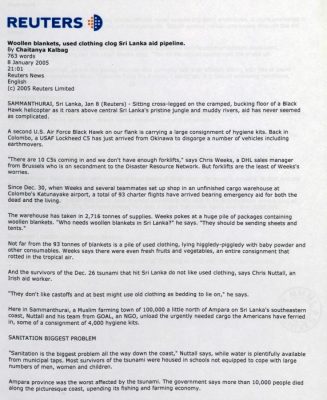Woollen blankets, used clothing clog Sri Lanka aid pipeline.
[Reuters]
Published date: 8th Jan 2005
8 January 2005
Reuters News
English
(c) 2005 Reuters Limited
SAMMANTHURAI, Sri Lanka, Jan 8 (Reuters) – Sitting cross-legged on the cramped, bucking floor of a Black Hawk helicopter as it roars above central Sri Lanka’s pristine jungle and muddy rivers, ald has never seemedas complicated.
A second U.S. Air Force Black Hawk on our flank is carrying a large consignment of hygiene kits. Back in Colombo, a USAF Lockheed C5 has just arrived from Okinawa to disgorge a number of vehicles including earthmovers.
“There are 10 C5s coming in and we don’t have enough forklifts,” says Chris Weeks, a DHL sales manager from Brussels who is on secondment to the Disaster Resource Network. But forklifts are the least of Weeks’s worries.
Since Dec. 30, when Weeks and several teammates set up shop in an unfinished cargo warehouse at Colombo’s Katunayake airport, a total of 93 charter flights have arrived bearing emergency aid for both the dead and the living.
The warehouse has taken in 2,716 tonnes of supplies. Weeks pokes at a huge pile of packages containing woollen blankets. “Who needs woollen blankets in Sri Lanka?” he says. “They should be sending sheets and tents.”
Not far from the 93 tonnes of blankets is a pile of used clothing, lying higgledy-piggledy with baby powder and other consumables. Weeks says there were even fresh fruits and vegetables, an entire consignment that rotted in the tropical air.
And the survivors of the Dec. 26 tsunami that hit Sri Lanka do not like used clothing, says Chris Nuttall, an Irish aid worker.
“They don’t like castoffs and at best might use old clothing as bedding to lie on,” he says.
Here in Sammanthurai, a Muslim farming town of 100,000 a little north of Ampara on Sri Lanka’s southeastern coast, Nuttall and his team from GOAL, an NGO, unload the urgently needed cargo the Americans have ferried In, some of a consignment of 4,000 hygiene kits.
SANITATION BIGGEST PROBLEM
“Sanitation is the biggest problem all the way down the coast,” Nuttall says, while water is plentifully available from municipal taps. Most survivors of the tsunami were housed in schools not equipped to cope with large numbers of men, women and children.
Ampara province was the worst affected by the tsunami. The government says more than 10,000 people died along the picturesque coast, upending its fishing and farming economy.
Back in Colombo, Weeks and his logistics team slump tired in their chairs when Christian Fabery, the site manager, announces that the airport authorities have issued only single-day passes. “The bureaucracy is incredible,” he sighs.
Weeks says his job is to keep the airport open for the planes thundering in non-stop with aid from a concerned world.
“There is no inventory control,” he says. “They didn’t keep track of what came in. People send their aid with no paperwork.”
He says Sri Lanka’s powerful Air Force, whose officers hover around the giant warehouse, is more interested in looking for suspected contraband in the aid consignments. Search parties periodically sweep through the aid boxes.
“The United Nations sent in six or seven boxes of very expensive mobile communications equipment, transceivers, transmitters and the like,” Weeks says. “The Air Force just confiscated the whole lot.” But he is philosophical, as are the young Marines who patiently talk with officials sitting with lots of paper forms near the warehouse door. “I wouldn’t say it’s a mess, I would say It is typical operating conditions,” Weeks says.
“DUMPING GROUND”
U.S. Marine Captain Rick Cary, who is in Colombo with the 3rd Transportation Support Battalion from Okinawa, says he expects to be in the Sri Lankan capital between four and six weeks.
“As the (U.S. Air Force planes) come in we offload and palletise the stuff and get it to go where it goes,” he says.
A few yards (metres) away Sri Lankan cadets poke desultorily at packages containing baby powder, rodenticides, and bottled water.
The Norwegian Red Cross has sent in several huge boxes of body bags – far away in Ampara, Nuttall and his team have been clearing rubble and finding new bodies.
Rod Lodge, from the British Red Cross, says medical equipment kits sent in by Scandinavian donors cost as much as $30,000 each. The chartered Boeing 747 that brought them over easily cost over $250,000.
“Don’t quote me, but the rich countries are using this place as a dumping ground,” says another aid worker.






